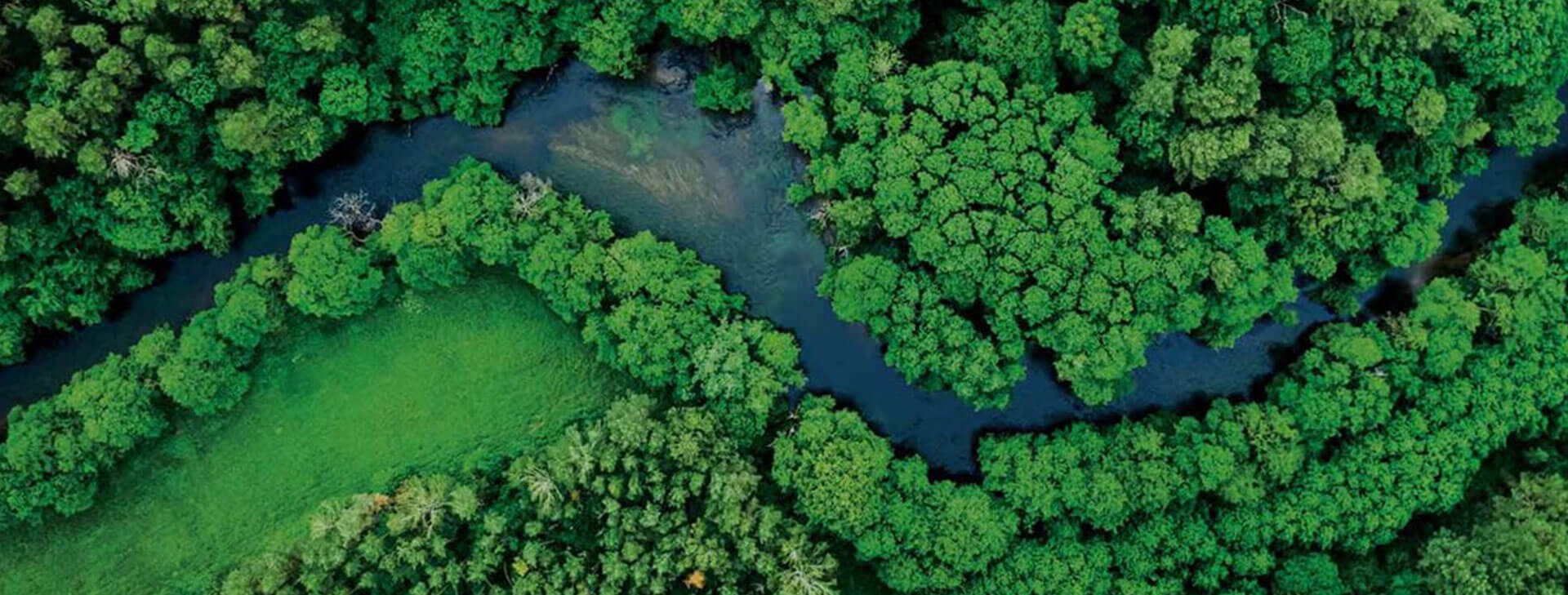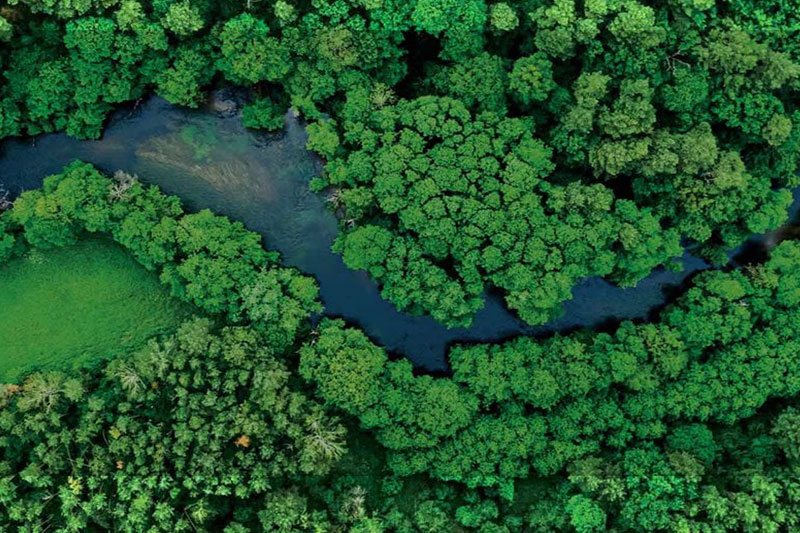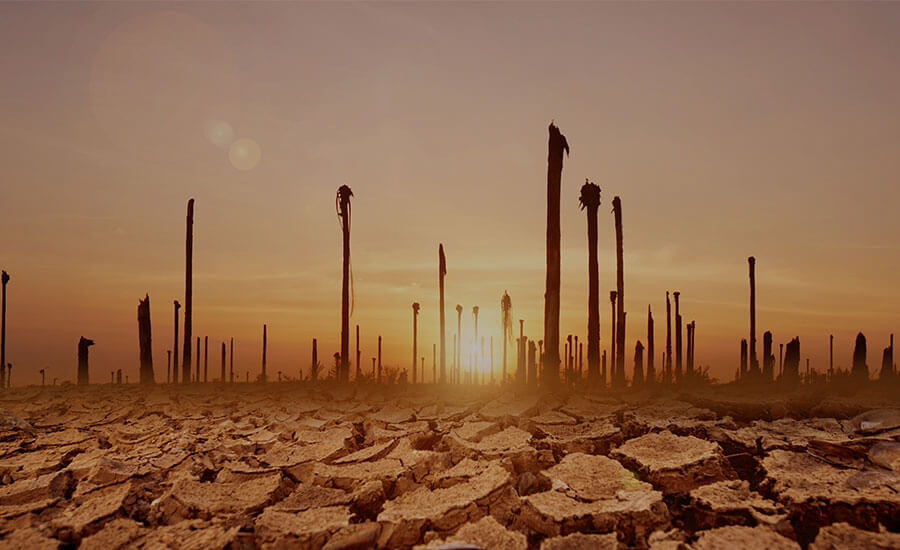In 2000, Asia had 61% of the earth's population and accounted for just 37% of its carbon emissions. In 2021, these figures were 59% and 58%.
Extreme weather events are unfolding in close succession throughout Asia, intensifying concerns over the impacts of climate change on both human rights and economic growth. More worrying still, experts believe that there is a 48% probability that, by 2026, the world will experience average temperatures of 1.5 degrees Celsius higher than the figure before the industrial revolution. More disruptive events will certainly accompany this change.
The global rise in carbon emissions, driven largely by the growth in Asian industry.
With its vast engines of economic growth, Asia is now the epicentre of concern. In the past two decades, the world has seen a 46% rise in carbon emissions, driven largely by the growth in Asian industry. In contrast, the net figure for emissions for the rest of the world has declined slightly over the same period. Asia is also considered the region most vulnerable to climate change’s impacts. The continent’s urban centres are highly exposed to the risks of sea level rise, extreme heat, typhoons and drought.
If Asia is central to efforts to address climate change at the global levels, then business across the region must step up to the challenge of climate change mitigation and adaptation. But they cannot do this alone. Climate financing and technology transfers will need to be provided by advanced economies from other regions, economies that on a historic basis, are responsible for the bulk of greenhouse gases (GHG) in our atmosphere today.
This report, Asia in Focus: Corporate Accountability and the Climate Action Agenda, looks at the role and potential of Asian industry to lead on climate action, a topic that inevitably requires a review of government regulation and state commercial activity as well. Relying on in-depth interviews with over 40 experts from business, government, NGOs, academia, think tanks and international organisations, as well as extensive desk research, the report’s key findings include:
Key findings
In 2000, the region had 61% of the earth's population and accounted for just 37% of its carbon emissions. In 2021, these figures were 59% and 58%, respectively. Looking ahead, Asia’s GHG output is likely to rise. Coal remains the dominant fuel for electricity generation, accounting for over 50% of power output in China, India, and Indonesia, and by 2031, this is projected to still be the case, except in China, where the figure will likely be reduced to 45%.2 While blame cannot be cast on Asia for today’s climate crisis, what business and government in the region do today, will impact on our planet for years to come.
The number of climate-change induced heatwaves has risen rapidly in recent decades across the globe, with some of the most extreme cases occurring in South Asia. A public health hazard, climate change also has important economic implications. The country most affected by heat stress is India, which lost 4.3% of working hours in 1995 and is projected to lose 5.8% of working hours in 2030.3. Agriculture will be among the most affected sectors by climate change, impacting economies and displacing people facing greater levels of food insecurity. The IPCC states in a 2022 report that the impact of climate-related extremes on food security, nutrition and livelihoods are “particularly acute and severe” for people living in Asia. The region is also home to 11 of the 15 cities most at risk from climate-change-induced flooding. According to a Greenpeace study, by 2050 the Asia-Pacific region may lose about US$1.2trn each year in capital stock from flood events.
Worldwide, litigation related to climate change roughly tripled between 2018 and 2022. Meanwhile, EU regulations with extraterritorial reach are increasingly holding companies in Asia and elsewhere to higher human rights and environmental standards. Other legal and compliance risks relate to the environmental impacts of business operations on land, including deforestation, as stakeholders are increasingly turning to the courts where such activity threatens their rights. Since 2010, the Business & Human Rights Resource Centre has documented 200 allegations of business-related, land rights abuses and Indigenous Peoples’ rights abuses.
Asian governments have signed numerous climate pledges and plans, and passed a multitude of regulations governing corporate behaviour towards the environment.Yet enforcement can be undercut by cronyism, corruption, poor accountability and weak human rights protections. Progress on climate change is also constrained in many Asian states due to a lack of the civic space necessary to hold bad actors accountable. The region is seeing a growing number of attacks on environmental and human rights defenders, undercutting constructive conversations on climate action.
A marked lack of political will to address GHG emissions exists across much of Asia, due in part to overriding economic growth priorities. Many governments have chosen to rely on cheap fossil fuels to get their economies back on track following two years of covid-19 lockdowns. High food and fuel prices have also made policy-makers more reluctant to impose further compliance mandates on business. In addition, taking on efforts to integrate green sources of energy would require large outlays of capital from countries with already constrained financial resources and any number of pressing needs. Even developing the capacity and technical expertise to monitor corporate emissions would place a heavy strain on limited state budgets.
Large companies are better placed to adjust to heightened compliance requirements. GHG mitigation and climate change adaptation are no exception. SMEs across Asia will need assistance to pay for and meet the requirements of government climate change strategies.
In 2000, the region had 61% of the earth's population and accounted for just 37% of its carbon emissions. In 2021, these figures were 59% and 58%, respectively. Looking ahead, Asia’s GHG output is likely to rise. Coal remains the dominant fuel for electricity generation, accounting for over 50% of power output in China, India, and Indonesia, and by 2031, this is projected to still be the case, except in China, where the figure will likely be reduced to 45%.2 While blame cannot be cast on Asia for today’s climate crisis, what business and government in the region do today, will impact on our planet for years to come.
The number of climate-change induced heatwaves has risen rapidly in recent decades across the globe, with some of the most extreme cases occurring in South Asia. A public health hazard, climate change also has important economic implications. The country most affected by heat stress is India, which lost 4.3% of working hours in 1995 and is projected to lose 5.8% of working hours in 2030.3. Agriculture will be among the most affected sectors by climate change, impacting economies and displacing people facing greater levels of food insecurity. The IPCC states in a 2022 report that the impact of climate-related extremes on food security, nutrition and livelihoods are “particularly acute and severe” for people living in Asia. The region is also home to 11 of the 15 cities most at risk from climate-change-induced flooding. According to a Greenpeace study, by 2050 the Asia-Pacific region may lose about US$1.2trn each year in capital stock from flood events.
Worldwide, litigation related to climate change roughly tripled between 2018 and 2022. Meanwhile, EU regulations with extraterritorial reach are increasingly holding companies in Asia and elsewhere to higher human rights and environmental standards. Other legal and compliance risks relate to the environmental impacts of business operations on land, including deforestation, as stakeholders are increasingly turning to the courts where such activity threatens their rights. Since 2010, the Business & Human Rights Resource Centre has documented 200 allegations of business-related, land rights abuses and Indigenous Peoples’ rights abuses.
Asian governments have signed numerous climate pledges and plans, and passed a multitude of regulations governing corporate behaviour towards the environment.Yet enforcement can be undercut by cronyism, corruption, poor accountability and weak human rights protections. Progress on climate change is also constrained in many Asian states due to a lack of the civic space necessary to hold bad actors accountable. The region is seeing a growing number of attacks on environmental and human rights defenders, undercutting constructive conversations on climate action.
A marked lack of political will to address GHG emissions exists across much of Asia, due in part to overriding economic growth priorities. Many governments have chosen to rely on cheap fossil fuels to get their economies back on track following two years of covid-19 lockdowns. High food and fuel prices have also made policy-makers more reluctant to impose further compliance mandates on business. In addition, taking on efforts to integrate green sources of energy would require large outlays of capital from countries with already constrained financial resources and any number of pressing needs. Even developing the capacity and technical expertise to monitor corporate emissions would place a heavy strain on limited state budgets.
Large companies are better placed to adjust to heightened compliance requirements. GHG mitigation and climate change adaptation are no exception. SMEs across Asia will need assistance to pay for and meet the requirements of government climate change strategies.
The UN Guiding Principles on Business and Human Rights (UNGPs) and other globally recognised frameworks can help governments and businesses address the challenges of climate change within a human rights context.
Governments: Three areas are of particular relevance for states in this field, the first of which involves law and policy formation. In addition to translating the newly recognised right to a clean, healthy and sustainable environment into domestic law, governments must ensure that corporate regulatory policies are made, and enacted, in a way that is consistent with human rights principles. This includes ensuring public participation in decision-making on infrastructure and mining projects, an approach that is not considered common to Asia. Second, states should leverage their own economic activity in ways that promote carbon mitigation and adaptation. This includes both the government’s own spending in the economy and the operation of the many substantial state-owned enterprises (SOE) in Asia. Third, governments need to establish and enforce environmental regulations while also supporting programmes to build capacities of SMEs to comply.

Companies: Every firm should conduct ongoing assessments of the impact of their operations on the environment, including but not limited to the guidance provided by the UNGPs on human rights due diligence. These assessments can help enterprises to reduce their carbon footprints and assess ways to lessen their impact on water, forests and biodiversity and air quality, and any implications these impacts may have on human rights. These analyses also need to take a broad view and include the behaviour of suppliers and customers to ensure there is a genuine enhancement of human rights and environmental rights performance. Finally, companies must be prepared to provide for remedies, if they find that they have fallen short of human rights or environmental standards.
Three business sectors have lessons for the rest
It is difficult to make detailed statements about what companies should do to address the human rights related impacts of climate change without looking at the context in which business operates. Accordingly, this study examines three industries in more detail:
Garments and fashion: Asia is the global centre of garment production, including footwear. The industry’s challenges include: the high levels of energy consumption within its lengthy supply chains; the large number of factories likely to be flooded in the next decade; and the impact of heat stress on workers. Smaller companies in major label supply chains seem to be doing little to reduce emissions or to adapt to climate change – this according to our expert interviewees. SMEs in the garment industry will thus need to “sharpen their game” as large labels focus increasingly on their overall GHG footprints. Leading players in the retail sector are also trying to source more green energy, which is proving difficult in Asia.
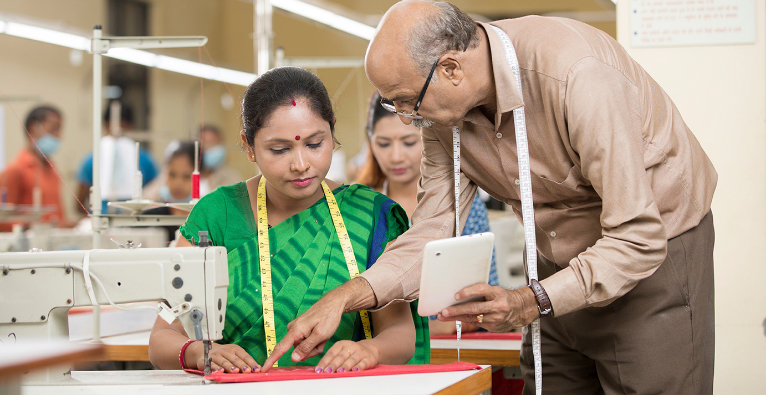
Industry challenges
High energy consumption within lengthy supply chains Large number of factories likely to be flooded in the next decade Impact of heat stress on workers
Palm oil and paper: These sectors are often associated with high levels of deforestation. As with the garment sector, resistance or inability to comply with responsible business practice standards may be more likely among the many small producers who sell to larger companies. Larger companies, driven by reputational considerations – rather than by the relatively small regulatory fines for causing environmental damage – are mostly taking two approaches to improve standards across the supply chain. One is simply to reduce the number of suppliers and cut out those that do not meet industry standards. The other approach involves working with smaller companies over a long period of time to help them improve.
Mining of rare-earth minerals: The technology behind green energy generation will require a growing volume of rare-earth elements. Yet, civil society groups make frequent allegations of human rights and environmental wrongdoing by the mining sector. Mining companies involved in “transitional minerals” will be under intense pressure to conduct human rights and environmental due diligence (HREDD), and other processes. Failure to conduct meaningful HREDD and reduce adverse impacts on human rights may delay the energy transition.
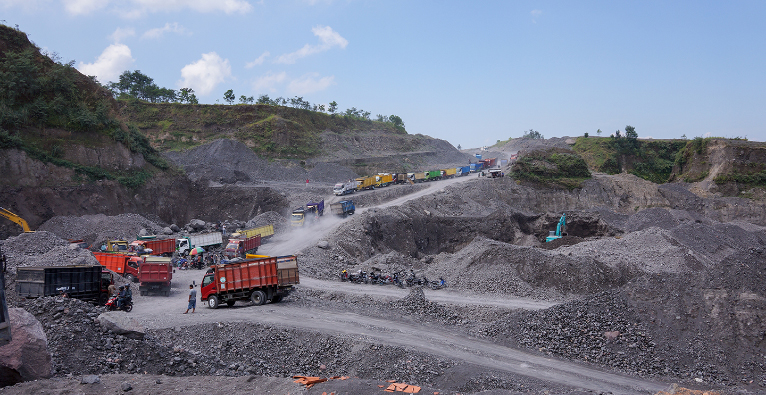
Mining companies involved in “transitional minerals” will be under intense pressure to conduct human rights and environmental due diligence, and other processes.
Download the report
Access the footnote sources, appendix information and charts by downloading the full PDF report
Written by






